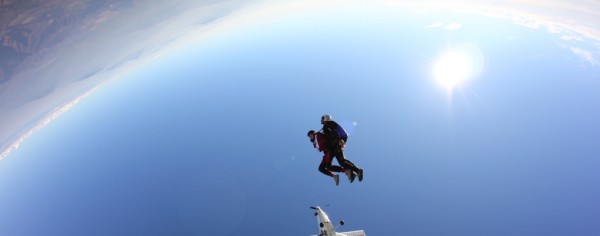Adventurous activities and sports like skydiving will always have some risk involved. With training, safety precautions, and ideal weather conditions these risks are negligible but in inclement weather, the risk for skydiving increases to the point where a jump will often need to be postponed or canceled for the day. All skydiving facilities in the United States must follow the United States Parachute Association (USPA) rules and regulations regarding weather and skydiving. However, apart from these rules, there is some leeway and variation in conventions. Sometimes one local facility will cancel jumps for the day while another stays open.

Having an idea of when jumps will be canceled or delayed can help you to plan a safe and enjoyable skydiving adventure. This page goes over the basics for ideal skydiving weather conditions. On the sidebar we also provide a detailed local weather forecast near your present location.
Skydiving in Wind
Wind is an important factor for a skydiver. The latest canopy designs have around 20 mile/hour forward moving speed. This provides the skydiver high maneuverability. On windy days, a skydiver should take into consideration the direction and the speed of the wind to land safely at their dropzone. The skydiving facility will always take wind speed and direction into account when determining where skydivers should jump from. Modern GPS integration can also help skydivers determine where to jump from and where to land.
As an additional safety measure, every skydiver should know a technique called spotting. Spotting involves selecting a highly recognizable location or structure from the air, that is located near your dropzone to be used as a milestone to be able to find your landing zone immediately.
In general, skydiving jumps will be canceled if winds or gusts exceed 15-20 mph (exact rules dependent on drop zone location). Depending on the size and geography of the drop zone, high winds could mean missing your landing zone and potentially hitting a tree or building with a potential for injury.
Skydiving in Rain and Thunderstorms
In light rain, skydiving is technically possible but rain drops hitting your skin and face at high speeds in freefall is uncomfortable and with the reduced visibility, it will generally be cancelled.
Skydiving during thunderstorms will always be canceled. Although it is again technically possible to make such a skydive, the erratic high winds and impaired visibility inherent with thunderstorms make skydiving very dangerous. Updrafts during thunderstorms can even lift a skydiver high into the sky and far from their drop zone.
Clouds and Visibility
Skydiving is applied under the visual flight rules in the United States which means certain visibility requirements must be met before a skydiving plane can take off. By law, the drop zone must be visible from the air where the skydiver exits the plane. This means the best day for skydiving will be free of any low clouds at 14,000 ft or under. Low clouds impair visibility and can cause a jump to be delayed or canceled.
Fog will also cause a jump to be delayed or cancelled. Be particularly mindful of fog when planning early morning jumps.
Low Temperatures and Winter Skydiving
Skydiving can be done at any temperature and winter is no excuse to stop skydiving! However, 45+ seconds of freefall winds during very cold days will not be pleasant if you are not prepared with full face protection and wind attire. Excluding a full bodysuit, several warm layers with a wind resistant coat or jacket on top will provide the most protection from cold winds.
Some skydiving facilities close during the winter seasons but many will stay open except on very cold days. Keep this in mind for deciding when and where to skydive. During snow and other inclement winter weather, skydiving will be cancelled regardless.